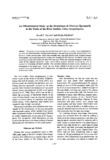An ultrastructural study on the occurrence of aberrant spermatids in the testis of the river sculpin, Cottus hangiongensis
Share
Abstract
The process of spermatogenesis and spermiogenesis in the river sculpin,Cottus hangiongensis, was observed ultrastructurally. During spermatogenesis, some germinal cysts in the seminal lobules were found to contain spermatocytes, which were provided with irregularly shaped nuclei, doughnut-shaped mitochondria, and atypical intercellular bridges with multiple disk-like cisternae. In addition, many cysts containing binuclear spermatids were observed in the testis. Within the condensed chromatin of the paired nuclei of the aberrant spermatids, highly electron-dense granules occurred, becoming the core of successively developing chromatin globules. The chromatin globules increased in size, resulting in an enlargement of the paired nuclei. These cells were finally released from the cyst into the lumen of the seminal lobules and underwent further degeneration, thus appearing as characteristic ‘spermatid masses’ in the mature testes.
Suggested Citation
Quinitio, G. F., & Takahashi, H. (1992). An ultrastructural study on the occurrence of aberrant spermatids in the testis of the river sculpin, Cottus hangiongensis. Japanese Journal of Ichthyology , 39(3), 235-241. https://doi.org/10.1007/BF02905481
Paksa
Taxonomic term
Mga koleksyon
- AQD Journal Articles [1248]

